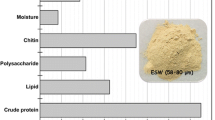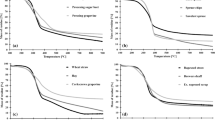Abstract
In the present work, evaluation of different conventional techniques, i.e., chemical oxygen demand (COD), biological oxygen demand, elemental analysis, Fourier transform infrared (FTIR), and gas chromatography used for estimating biodegradation of grease waste was carried out. In this order grease waste was incubated with Penicillium chrysogenum for 7–30 days and analyzed percentage of degradation. After 15 days of incubation, the percentages of reduction in COD, carbon, hydrogen, and nitrogen content of grease waste were found 28, 53.5, 12.7, and 0, respectively. Further it was analyzed by FTIR and gas chromatography–mass spectroscopy (GC-MS) and observed that bifurcated peaks of grease waste at 2,926 and 2,855 cm−1 had reduced remarkably, which corresponds to aliphatic hydrocarbons, while new broad peaks appeared at 3,400 cm−1 indicating addition of oxygen molecule to reduced aliphatic hydrocarbon. GC-MS study also supports the results of FTIR, COD, and elemental analysis, but quantification of the percentage of degradation was difficult and limited to volatile organic content, while COD and elemental analysis were found more accurate and more informative. The current study would be helpful in the estimation of biodegradability not only of grease waste but also of other complex nonbiodegradable compounds polluting the environment.






Similar content being viewed by others
References
Hach, C. C., Klein, R. L., & Gibbs, C. R. (1997). Introduction to Biochemical Oxygen Demand. Technical Information Series-Booklet No. 7. Hach Company, Printed in U.S.A., 1–22.
Strotmann, U., Reuschenbach, P., Schwarz, H., & Pagga, U. (2004). Applied and Environmental Microbiology, 70, 4621–4628.
Fadeeva, V. P., Tikhova, V. D., & Nikulicheva, O. N. (2008). Journal of Analytical Chemistry, 63, 1094–1106.
Fitzpatrick, M. G., & Tan, S. S. (1993). Chemistry in New Zealand, 57, 22–23.
US EPA Method 8015B. (1986) Total petroleum hydrocarbons (TPH) Analysis gasoline and diesel fuel.
Pawlak, Z., Rauckyte, T., & Oloyede, A. (2008). Journal of Achievements in Materials and Manufacturing Engineering, 26, 11–17.
Szulejko, J. E., & Solouki, T. (2002). Analytical Chemistry, 74, 3434–3442.
Kujawinski, E. B., Freitas, M. A., Zang, X., Hatcher, P. G., Green-Church, K. B., & Jones, R. B. (2002). Organic Geochemistry, 33, 171–180.
Kumar, S., Katiyar, N., Ingle, P., & Negi, S. (2011). Bioresource Technology, 102, 4909–4912.
Bushnell, D. L., & Haas, H. F. (1941). Kansas Agricultural Experiment Station, 199, 653–673.
Eaton, A., Clesceri, L., & Greenberg, A. (1995). Standard method for examination of water and wastewater (19th ed.). American: Public Health Association (APHA).
Thompson, M. (2008) Analytical Methods Committee. 29, ISSN 1757–5958
Kutty, S. R. M., Ngatenah, S. N. I., Johan, N. A., & Amat, K. A. C. (2011). International Conference on Environment and Industrial Innovation IPCBEE, 12, 90–94.
Hamza, U. D., Mohammed, I. A., & Ibrahim, S. (2009). Researcher, 1, 17–23.
Eckenfelder, W. W., Jr. (1989). Industrial Water Pollution and Its Control, 2, 13–21.
Udeni, A. H. A., Gunawardena, H. D., & Amaramali, J. Y. N. (1993). Journal of the National Science Council of Sri Lanka, 21, 259–266.
Organisation for Economic Co-operation and Development. (1993) OECD guidelines for testing of chemicals. OECD 301 A. DOC die-away test.
Cann, P. M., & Spikes, H. A. (2005). Tribology Letters, 19, 289–297.
Aitken, C. M., Jones, D. M., & Larter, S. R. (2004). Nature, 431, 291–294.
Okoh, A. I. (2006). Biotechnology and Molecular Biology Reviews, 1, 38–50.
McDonald, I. R., Miguez, C. B., Rogge, G., Bourque, D., Wendlandt, K. D., Groleau, D., et al. (2006). FEMS Microbiology Letters, 255, 225–232.
Mecozzi, M., Moscato, F., Pietroletti, M., Quarto, F., Oteri, F., & Cicero, A. M. (2009). Global NEST Journal, 11, 593–600.
Kamnev, A. A. (2008). Spectroscopy, 22, 83–95.
Headley, J. V., & Peru, K. M. (2002). Journal of AOAC International, 85, 182–187.
Kajdas, C. (1969). Organic Mass Spectrometry, 2, 1049–1060.
Qian, K., Edwards, K. E., Dechert, G. J., Jaffe, S. B., Green, L. A., & Olmstead, W. N. (2008). Analytical Chemistry, 80, 849–855.
Eide, I., & Zahlsen, K. (2005). Energy and Fuel, 19, 964–967.
Kullman, S. W., & Matsumura, F. (1996). Applied and Environmental Microbiology, 62, 593–600.
Author information
Authors and Affiliations
Corresponding author
Rights and permissions
About this article
Cite this article
Negi, S., Kumar, S. Evaluation of Techniques Used for Parameters Estimation: an Application to Bioremediation of Grease Waste. Appl Biochem Biotechnol 167, 1613–1621 (2012). https://doi.org/10.1007/s12010-012-9562-6
Received:
Accepted:
Published:
Issue Date:
DOI: https://doi.org/10.1007/s12010-012-9562-6




